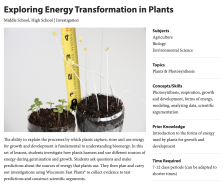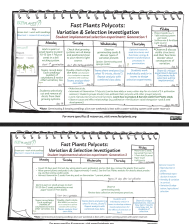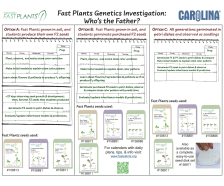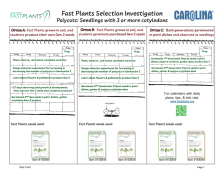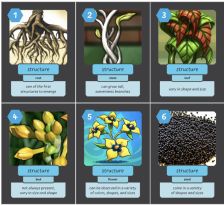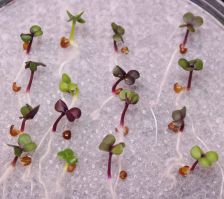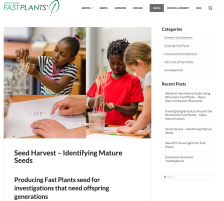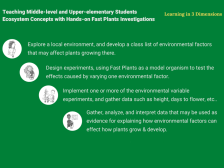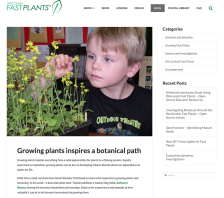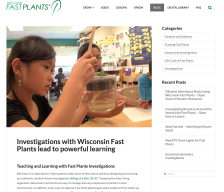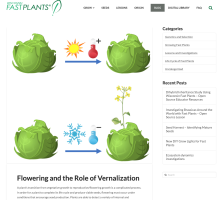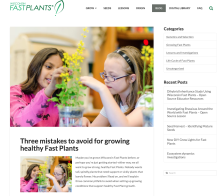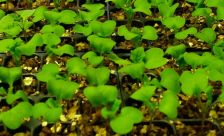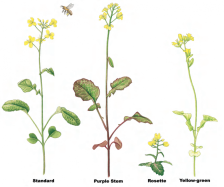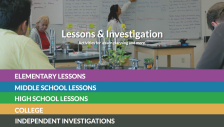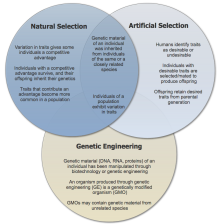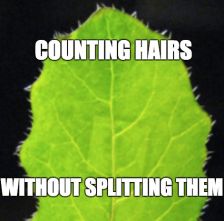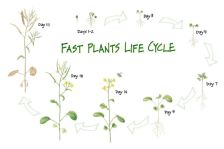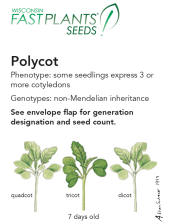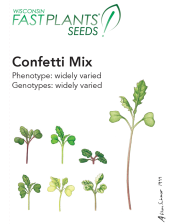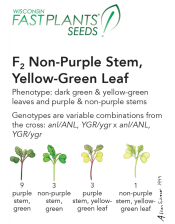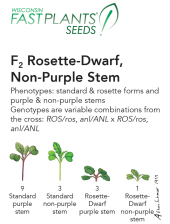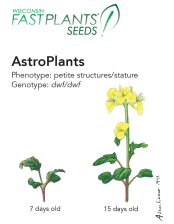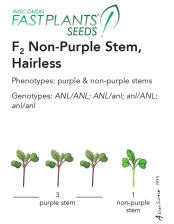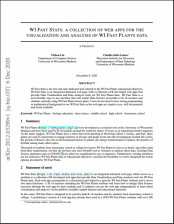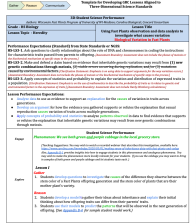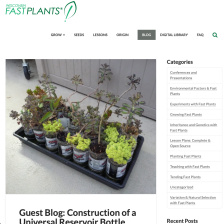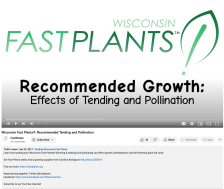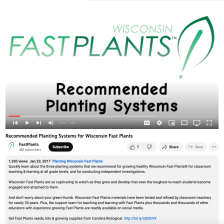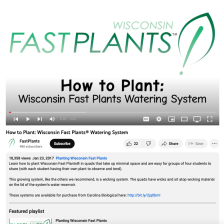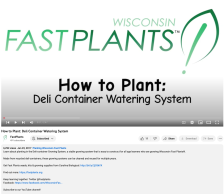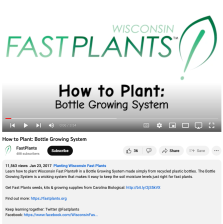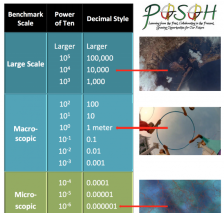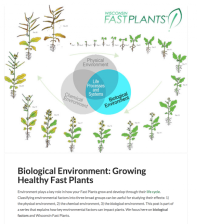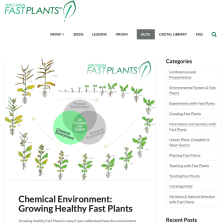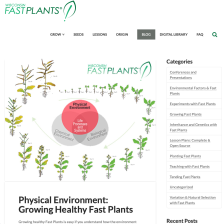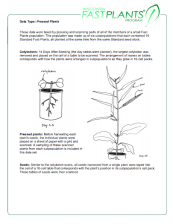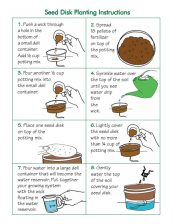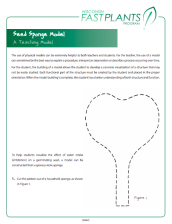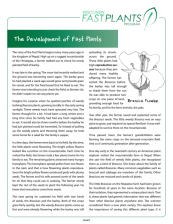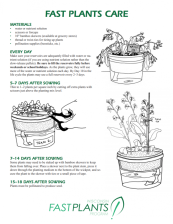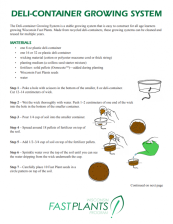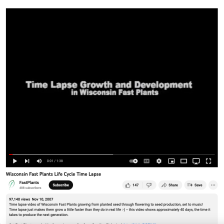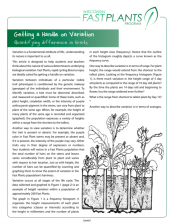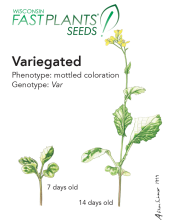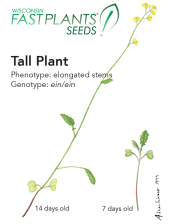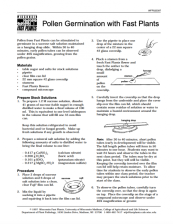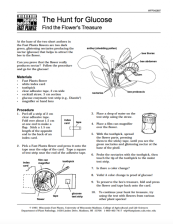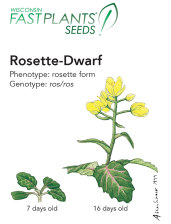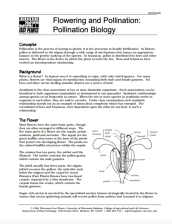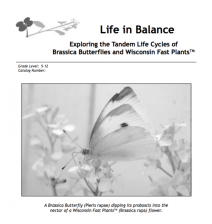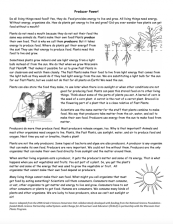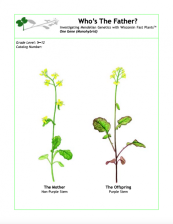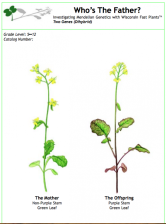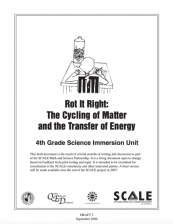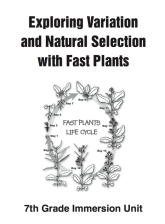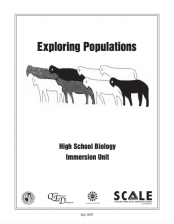Browse Resources
Science -- Biological and life sciences
Resources | |
|---|---|
In this set of lessons and Fast Plants experiment, students investigate how plants harness and use different sources of energy during germination and growth. Students ask questions and make predictions about the sources of energy that plants use. They then plan and carry out investigations using...
This PDF document shows in detail the possible day-to-day learning associated with the 6-week version of the Fast Plants Polycot Selection / Plant Breeding Investigation (aka Option A).
Conducting this selection / plant breeding investigation uses Generation 1 Polycot Fast Plants seed lines, with...
This PDF document shows three calendars side-by-side for comparing the time and materials needed for three different versions of the Fast Plants Mendelian Inheritance Investigation that is commonly called "Who's the Father?"
Option A involves students growing the F1 generation of Fast Plants in...
This PDF document shows in greater detail the possible day-to-day learning associated with the 3-week version of the Fast Plants Polycot Selection Investigation.
Conducting this selection investigation in just 3 weeks involves using Polycot Fast Plants seed lines for both Generation 1 and 2...
This PDF document shows three calendars side-by-side for comparing the time and materials needed for three different versions of the Fast Plants Polycot Selection Investigation.
Option A involves Fast Plants grown in soil, and students select for or against polycots, then produce their own...
This activity is designed for teaching the functions of basic plant structures. The activity uses two types of matching cards containing either
a) Structures - depictions of plant structures
b) Functions - descriptions of the function of plant structures
Using the downloadable PDF (including...
Preparing Your Students for the Future: Undergraduate Research Experiences with RapidCycling BrassicThis article with practical instructions about using Fast Plants in undergraduate research experiences was published as an addendum to a workshop given at the 2017 ABLE Conference in Madison, WI. Contains ideas for helping students at high school and undergraduate levels to conduct independent...
This blog post from the Wisconsin Fast Plants features open source educator resources, developed in 2023. These resources support the teaching of genetics concepts with tools focused on a Dihybrid Inheritance Study. This study provides a two-week approach for observing three generations of plant...
This blog post from the Wisconsin Fast Plants features open source educator resources, developed in 2023. These NGSS- and Ag-Standards aligned resources, named Investigating Brassicas Around the World with Fast Plants include a full lesson plan with supporting plant breeding activities, video about...
This blog post from the Fast Plants team provides detailed advice and instructions on the ideal timing for harvesting Fast Plants seeds. It is important to harvest at the correct time, to ensure maximum seed viability for planting the next generation. This post addresses several frequently asked...
This blog post from the Wisconsin Fast Plants website features an NGSS-aligned Open Source Lesson Plan for Investigating Ecosystem Dynamics with Fast Plants. The featured lesson plan is available to be downloaded and edited as needed via Google Drive. The investigation challenges students to gather...
This blog post on the Fast Plants website discusses the concept of plant blindness (the inability to see or notice the plants in one's own environment) and the importance of ending plant blindness and supporting plant vision. Fast Plants are an effective introduction to growing and noticing plants:...
This blog post on the Fast Plants website shares content from podcaster, Matt Candeias, host of the In Defense of Plants podcast. In an interview with Mary Williams of the American Society of Plant Biologists, Matt discusses the important connection fostered between physical experiences and...
This blog post shared on the Wisconsin Fast Plants website is a guest post by Daniel Murphy, author of the weekly blog Awkward Botany. In this post, Daniel shares his firsthand account of his experiences growing plants and becoming "a bona fide plant nerd." This post is a great example of the value...
This blog post from the Wisconsin Fast Plants website is a guest post by classroom teacher, Julie LaConte, of Rossman School in Creve Coeur, MO. In this post, Julie describes her experiences researching, preparing for, and teaching with Fast Plants in her classroom. Thank you for sharing your...
This blog post, written by the MiniPCR Team, describes the use of biotechnology kits and equipment (available from multiple suppliers) in the classroom to help students and learners understand the connection between observable phenotypic traits and underlying genotypes. These investigations can be...
This blog post from the Wisconsin Fast Plants website describes the value of using Fast Plants as a model organism for biological and environmental investigations. This post is primarily an index of Fast Plants resources, providing prompts for teaching goals and suggesting Fast Plants kits...
This blog post from the Fast Plants Team addresses the question "Do Fast Plants need Vernalization to Flower?". This post describes the concept of vernalization (requiring a cold period to induce flowering) and its role in regulating the development of flower structures in flowering plants. Some...
This blog post from the Wisconsin Fast Plants Team describes three ways to optimize your growing environment to grow healthy Fast Plants.
Tips for growing healthy plants are focused around the following three concepts, with descriptions of ideal environmental conditions for each:
1. Not enough...
This blog post from the Wisconsin Fast Plants website provides an overview and list of resources for teaching about observable variation and measuring selection (focusing on leaf hairs/trichomes). This blog is primarily a point of reference for other Fast Plants teaching resources.
This blog post from the Wisconsin Fast Plants website provides an overview and list of resources for teaching about heredity and inheritance patterns with Fast Plants seed varieties. This blog is primarily a point of reference for other Fast Plants teaching resources, but includes specific detail...
This blog post from the Wisconsin Fast Plants website provides an overview and list of resources for teaching life science topics with Wisconsin Fast Plants. This blog is primarily a point of reference for other Fast Plants teaching resources.
This blog post from the Fast Plants Team addresses the question "Are Wisconsin Fast Plants Genetically Engineered Plants?". This post describes the origins of Fast Plants (they are the result of conventional plant breeding, not genetic engineering), defines terms related to plant breeding and...
This blog post from the Wisconsin Fast Plants website describes the observation of plant hairs (trichomes) for conducting a selective breeding experiment (such as in AP Biology investigations). The number of hairs is variable in Fast Plants seed varieties, and selection for or against plant...
This blog post from the Wisconsin Fast Plants website describes the value of using Fast Plants as a model organism to teach plant life cycles at multiple grade levels. Content includes an overview of plant growth stages (including videos) and links to resources and activities that can enrich...
This blog post from the Fast Plants team addresses the question "can bee sticks sting?" (no, bee sticks cannot sting) and provides information on the use of bee sticks for pollination of Fast Plants in the classroom.
This is a page on the Fast Plants website, describing the Polycot variety of Fast Plants (Brassica rapa). Two generations of the Polycot variety are available, each with a different % of expression of the polycot trait. This page includes suggestions for investigations and teaching applications...
This is a page on the Fast Plants website, describing the Confetti Seed Mix variety of Wisconsin Fast Plants (Brassica rapa). Confetti Mix includes phenotypes from several Fast Plants varieties, including purple stem, non-purple stem, yellow-green leaf, rosette-dwarf, tall plant, petite, variegated,...
This is a page on the Fast Plants website, describing the F2 Non-Purple Stem, Yellow-Green Leaf variety of Fast Plants (Brassica rapa). This page includes suggestions for investigations and teaching applications using this seed variety, including use as a model organism in teaching Mendelian...
This is a page on the Fast Plants website, describing the F2 Rosette-Dwarf, Non-Purple Stem variety of Fast Plants (Brassica rapa). This page includes suggestions for investigations and teaching applications using this seed variety, including use as a model organism in teaching Mendelian genetics...
This is a page on the Fast Plants website, describing the F1 Rosette-Dwarf, Non-Purple Stem variety of Fast Plants (Brassica rapa). This page includes suggestions for investigations and teaching applications using this seed variety, including use as a model organism in teaching Mendelian genetics...
This is a page on the Fast Plants website, describing the AstroPlants variety of Fast Plants (Brassica rapa). This page includes suggestions for investigations and teaching applications using this seed variety.
This is a page on the Fast Plants website, describing the F2 Non-Purple Stem variety of Fast Plants (Brassica rapa). This page includes suggestions for investigations and teaching applications using this seed variety, including use as a model organism in teaching Mendelian genetics with a monohybrid...
This investigation begins with a phenomenon that is evidenced in most every produce aisle: Many of the vegetables that botanists classify as Brassica look and taste different. This investigation aligns with middle and high school Next Generation Science Standards as well as with agricultural science...
WI Fast Stats is a browser-based data analysis and visualization tool that can be used alongside Wisconsin Fast Plants. WI Fast Stats has a set of R-developed unique web apps that corresponds to specific WI Fast Plants webinars and dataset (such as Cotyledon, or Ecosystem), to make data analysis...
This 5-page article is written by Yizhou Liu and Claudia Solis-Lemus and introduces Wisconsin Fast Stats, a collection of R-developed web apps of data analysis and visualization tools for educators that accompany learning activities from Wisconsin Fast Plants. The article covers topics such as...
In this 26-page investigation—co-developed for secondary grades by teachers, the Wisconsin Fast Plants Program at UW-Madison, The Concord Consortium data scientists, and developers from Carolina Biological Supply, and Brett Moulding—learners investigate variation and inheritance in the “three...
This resource, provided by Wisconsin Fast Plants and CurrikiStudio, contains a set of six different learning activities that can be implemented in classrooms to teach natural selection. Organized in playlists, these interactive lessons guide students through understanding and applying knowledge of...
This lesson plan, from the University of Wisconsin-Madisons Wisconsin Fast Plants, is for a high school biology investigation into evolution and artificial selection while using Fast Plants polycot seeds. The lesson plan describes student science performance for in-classroom learning as well as...
This blog post from the University of Wisconsin-Madison's Wisconsin Fast Plants, describes an investigation that educators can implement in the classroom to facilitate students' learning about variation and natural selection through firsthand observations and hands-on data collection in a very short...
This blog post, written by Joel Cryer of Bottle Biology, provides instructions to construct an inexpensive, self-watering planter that can be used to grow Wisconsin Fast Plants. The blog covers the materials and tools needed, as well as step-by-step instructions to create a universal reservoir...
This video is provided by Wisconsin Fast Plants and demonstrates how to tend and pollinate Fast Plants as they grow and develop. While both tending to and pollinating Fast Plants is the recommended approach, this video features an experiment to illustrate the effect that tending and pollination has...
This video is provided by Wisconsin Fast Plants, and introduces three recommended planting systems to use for planting Fast Plants seeds. The video gives an overview of the different methods: the Deli Container, the Wisconsin Fast Plants Watering System, and the Bottle Growing System. This recording...
This video is provided by Wisconsin Fast Plants, and demonstrates how to plant Fast Plant seeds using a quad-planter and wicking reservoir system. The video gives an overview of the materials necessary to grow plants with this method, and also provides step-by-step instructions guiding the process....
This video is provided by Wisconsin Fast Plants and demonstrates how to plant Fast Plants seeds using the Deli Container Growing System. The video gives an overview of the materials necessary to grow plants with this method, and also provides step-by-step instructions guiding the process. This...
This video is provided by Wisconsin Fast Plants and demonstrates how to plant Fast Plants seeds using the Bottle Growing System. The video gives an overview of the materials necessary to grow with this method, and also provides step-by-step instructions guiding the process. This recording runs for...
This is a printable poster resource developed by a collaboration of educators in the POSOH Project for teaching about systems and scale. This poster correlates with an excerpt from the video Cosmic Voyage about systems and scale, narrated by Morgan Freeman. A debrief discussion of that video excerpt...
Read this blog post for background information about the relationship between the biological environment and life processes and systems in Fast Plants.
Growing healthy Fast Plants is easy if you understand how the environment can affect growth and development. Three broad categories of...
Read this blog post for background information about the relationship between the chemical environment and life processes and systems in Fast Plants. Growing healthy Fast Plants is easy if you understand how the environment can affect growth and development. Three broad categories of environmental...
Read this blog post for background information about the relationship between the physical environment and life processes and systems in Fast Plants.
Growing healthy Fast Plants is easy if you understand how the environment can affect growth and development. Three broad categories of environmental...
These data sets were meticulously collected by Dr. Paul Williams in an investigation in which we were interested in learning about how nutrient limitations effect a variety of easily observable and measureable Fast Plant traits. Observations were made and recorded at different points in the plants'...
Illustrated instructions for constructing and planting seed disks in the Fast Plants deli-container growing system. This is a stable growing system that is easy to construct for all age learners, and works well for growing Wisconsin Fast Plants. Made from recycled deli-containers, these growing...
This 2-page handout gives instructions for making the seed sponge model that was developed by the Wisconsin Fast Plants Program as a tool for learning about germination. Visualizing what is inside a seed and how those structures function during germination is modeled, using a simple kitchen sponge....
Download this complete set of lessons for an elementary, NGSS-aligned inquiry that foregrounds engineering practices. During the days that are supported by this investigation, students observe flowers on their 14 to 16 day old Fast Plants along with bee structures, learning to connect how the shape...
This is "The Story of Fast Plants" - a short story of the origins of Brassicas and the work of Dr. Paul Williams, developing Brassica rapa. Reading level ~7th grade.
This is a jpg version of the Wisconsin Fast Plants life cycle that is found on our website. These Fast Plant illustrations were drawn by Alison Schroeer.
This four-page handout explains the key steps to follow when caring for Wisconsin Fast Plants (Brassica rapa) throughout their life cycle, from sowing through harvesting seeds. This handout includes information about the materials needed, methods for tending and caring for your plants, and...
Illustrated instructions for constructing and planting in the Fast Plants deli-container growing system. This is a stable growing system that is easy to construct for all age learners, and works well for growing Wisconsin Fast Plants. Made from recycled deli-containers, these growing systems can be...
On YouTube: Time lapse video of Wisconsin Fast Plants growing from planted seed through flowering to seed production, set to music! Time lapse just makes them grow a little faster than they do in real life -- this video shows approximately 40 days, the time it takes to produce the next generation.
This article is designed to help students and teachers think about the nature of various determinants underlying biological variation. Teachers facilitating any selection investigation will find this background information helpful, including those planning for the AP Biology Lab 1 of Big Idea 1:...
This fill-in-the-blank timeline is a planning tool for teachers to use when figuring out when to begin the steps associated with conducting a two-generation artificial selection experiment using Fast Plants. Teachers preparing for any selection experiment will find this timeline helpful, including...
This Farming Fast Plants activity introduces a classroom investigation that is easily adaptable for all grade levels and designed to engage teachers and students as investigators. The activity has the practical outcome of producing an abundant supply of Fast Plants seed for future classroom use and...
This is a page on the Fast Plants website, describing the F1 Non-Purple Stem variety of Fast Plants (Brassica rapa). This page includes suggestions for investigations and teaching applications using this seed variety, including use as a model organism in teaching Mendelian genetics with a monohybrid...
This is a page on the Fast Plants website, describing the Non-Purple Stem, Yellow-Green Leaf variety of Fast Plants (Brassica rapa). This page includes suggestions for investigations and teaching applications using this seed variety.
This is a page on the Fast Plants website, describing the Variegated variety of Fast Plants (Brassica rapa). This page includes suggestions for investigations and teaching applications using this seed variety.
This is a page on the Fast Plants website, describing the Tall Plant variety of Fast Plants (Brassica rapa). This page includes suggestions for investigations and teaching applications using this seed variety.
Protocol for germinating Fast Plants pollen in a sucrose-salt solution
This is a page on the Fast Plants website, describing the Petite variety of Fast Plants (Brassica rapa). This page includes suggestions for investigations and teaching applications using this seed variety.
Background information and activity investigating the Fast Plant nectaries and their functions.
This is a page on the Fast Plants website, describing the Rosette-Dwarf variety of Fast Plants (Brassica rapa). This page includes suggestions for investigations and teaching applications using this seed variety.
This is a page on the Fast Plants website, describing the F1 Non-Purple Stem, Yellow-Green Leaf variety of Fast Plants (Brassica rapa). This page includes suggestions for investigations and teaching applications using this seed variety, including use as a model organism in teaching Mendelian...
Turnips, Chinese cabbage and Wisconsin Fast Plants (Rbr) look very different. Yet, they actually belong to the same species. This means that they have the same number of chromosomes and they can cross breed and produce fertile offspring. But how can you prove that plants that look so different are...
This pdf includes background information and an activity for engaging students in the processes that occur during pollination, fertilization and seed development in Fast Plants. Pollination is explained and illustrated and an activity for students to pollinate Fast Plants and observe reproductive...
Download this complete unit of instructions to conduct an ecosystem inquiry. In this investigation, students have the opportunity to witness first-hand the dynamic relationship between Brassica butterflies and Wisconsin Fast Plants. Students are responsible for tending the butterflies and plants...
An article written for children, this reading explains the role of plants as producers. It is written at a grade 4-5 reading level, and it is a good supplement to the evidence that students can observe and record through experimentation with photosynthesis.
In this investigation, students will gather their own evidence to explain how inheritance works. As they observe three generations of Wisconsin Fast Plants, students will unravel a mystery of paternity: What is the father’s phenotype? Is it the same as the mother’s phenotype or the offspring’s...
Download the complete instructions for a high school level inheritance and genetics inquiry, using Wisconsin Fast Plants. In this investigation, students gather their own evidence to explain how inheritance works. As they observe three generations of Wisconsin Fast Plants, students unravel a...
This Immersion Unit provides a coherent series of lessons designed to guide students in developing deep conceptual understanding that is aligned with the National standards, key science concepts, and essential features of classroom inquiry (as defined by the National Science Education Standards)....
Download this complete and coherently designed, middle school level unit to teach fundamental concepts that underpin the theory of evolution. The unit was collaboratively designed by teachers, college faculty & staff, and the Fast Plants Program at UW-Madison to support student-centered...
This Immersion Unit provides a coherent series of lessons designed to guide students in developing deep conceptual understanding that is aligned with the standards, key science concepts, and essential features of classroom inquiry (as defined by the National Science Education Standards).
Unit...
| |
| Next → | |
